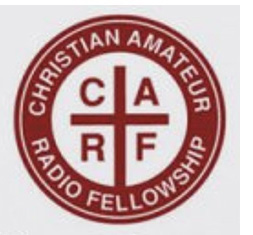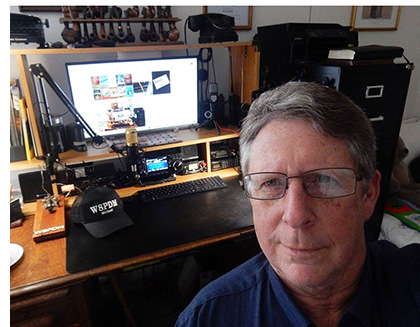By Michael Wetzel
The Christian Amateur Radio Fellowship (CARF) formed at the North American Christian Convention during the summer of 1966 as a way to promote fellowship among Independent Christian Churches and Churches of Christ, our Christian colleges, and as a service to missionaries.

CARF founder Gerald L. Fargusson (call sign W9JSQ), former head of the Christian Education Department at Lincoln (Ill.) Christian College, believed ham radio should be more than just a hobby; it should also be a tool for ministry. The “Grandfather of CARF” (as Fargusson is affectionately known) encouraged missionaries to become licensed and to take amateur radio with them to the mission field. Fargusson died in 2001.
In the early days of CARF, when cell phones and the internet were still long off and long-distance calling was a drain on the wallet, ham radio was a logical alternative. Ham radio was popular back then, and recent statistics indicate it continues to grow a little each year.
CARF has a website but no headquarters. The fellowship consists of hundreds of Christian amateur radio operators in North America and around the world. Members annually elect three officers who serve voluntarily as the executive committee.
While it is affiliated with Independent Christian Churches, the CARF Net is open to all Christian amateur radio operators to enjoy a time of fellowship, daily devotion, and prayer. CARF meets on-the-air at 3.930MHz, at 7:00 a.m. (Eastern) Monday through Saturday, with six different net control operators/hosts.
HAM RADIO ON THE MISSION FIELD
Tom Chamberlin was a missionary and an amateur radio operator who retired recently after 26 years with Team Expansion, which he served as a field coordinator. He supervised teams of missionaries in several Latin American countries as well as Spain, England, Ireland, Israel, and Bosnia.
Early in his missionary service, he and his wife served near Melipilla and Santiago, Chile, and also in Mexico. In Santiago, Chamberlin set up a 60-foot tower to communicate by radio. He said the tower was an easy climb at the bottom, but toward the top it narrowed to a foot or so. He climbed it and planted his antenna on top. CARF provided one of his first radios. Every week or so he would contact his ham buddies in Michigan with news and reports.
When serving in Chile, Chamberlin helped save lives. One day, he picked up an SOS sent out by a woman whose boat was sinking in a storm in the South Pacific. The woman and her husband (he spoke only Japanese) were desperately in need of help. Tom was the only one to hear her call, and he reported it to the coast guard. It took rescuers a day to find the boat, and Tom stayed on the radio frequency that whole time. If he had not heard their call for help, the couple probably would have died.
Ham radio is playing a crucial role in the war in Ukraine. Nick (UR6QV) and his group of hams are communicating news and needs as they arise.
“The front line stopped 40 kilometers from our city,” Nick says. “Air raid alarms sound three to ten times a day. Sometimes we hear the arrival of ballistic missiles. Every week there are wounded and dead. A lot of destroyed buildings. Despite this, we hold on and continue our work.
“We continue to provide assistance to radio amateurs who evacuated from the combat zone . . . who left everything and came empty-handed. My team of friends and like-minded people continue to develop amateur radio in Ukraine, particularly the Zaporozhe Amateur Radio Club.”

HISTORY AND POPULARITY OF HAM RADIO
Today, many people have no clue about amateur radio; they hear the word ham and think of Easter. People sometimes ask whether ham radio still exists. It does! Currently there are more than 700,000 operators in the United States. and over 3 million worldwide.
Some people think ham radio and citizens band (or CB) radio are the same thing. They are not.
CB radios are used by truckers to share road reports and to help them stay awake on long trips. CB radios communicate over short distances, and just about anyone can buy and use one. Amateur radio operators, by contrast, are licensed by the Federal Communications Commission. Licensure requires passing a government test on electronics, procedures, and rules. There are three levels of licensure: technician, general, and extra. Each level grants privileges on more frequencies and bandwidth. There is no age limit on applying for an amateur radio license.
Amateur radio operators are frequently called on in times of emergencies (such as tornadoes, hurricanes, fires, earthquakes, etc.) to help with communications. When cell towers fall or power lines are knocked out, hams can still get crucial messages out to those waiting for news.
Radio has been around since the late 1800s, but amateur radio as practiced today dates to the early 1900s. A wide variety of people have been operators, including nationally known figures such as Walter Cronkite, Chet Atkins, and Tim Allen. Operators can set up a ham shack in their basement, garage, or closet. Although modern technology has seemingly surpassed it, the place of ham radio is still alive and active on the mission field and around the world.
Learn more about amateur radio and the Christian Amateur Radio Fellowship by visiting their website, www.carf.net, or tuning in for morning worship at 7:00 (Eastern) Monday through Saturday at 3.930MHz.
Michael Wetzel (W8QF) serves as executive director of Shepherd’s Purse ministry working in Ukraine and India for over 20 years.

Michael-Great article on the history of CARF and ham radio activities in this modern world
of technology. I am CARF No.#37
That’s so cool! My dad and I played around with ham radio a bit when I was young. It’s neat to hear that it’s still around and being used in these circumstances!
Sounds interesting. I would like to reach Israel on HF and discuss portions like Deuteronomy 18, Isaiah 53, etc. Can you tell me what denominational doctrine you hold?
Any DMR talkgroups?